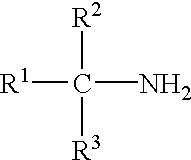Recovery and transportation of heavy crude oils
a crude oil and transportation technology, applied in the field of aminechelate complexes, can solve the problems of limited and difficult methods, affecting the efficiency of crude oil recovery,
- Summary
- Abstract
- Description
- Claims
- Application Information
AI Technical Summary
Benefits of technology
Problems solved by technology
Method used
Image
Examples
example 1
To a 3-necked round bottom flask equipped with a mechanical stirrer, heating mantle, addition funnel and reflux condenser was added 0.5 moles of an isomeric mixture of C.sub.12 to C.sub.14 tertiary alkyl primary amines. The mixture was heated to about 60.degree. C., at which time 0.2 moles of EDTA was slowly added to the amine mixture through the additional funnel, with stirring, to maintain the temperature between 80 and 100.degree. C. When addition was completed, the reaction temperature was raised to 120-140.degree. C. and maintained for about an hour (or until the EDTA was completely dissolved). The pH of the mixture was checked, and if below 8.5, additional amine was added. The reaction mixture was then allowed to cool to room temperature.
example 2
To a 3-necked round bottom flask equipped with a mechanical stirrer, heating mantle, addition funnel and reflux condenser was added 0.26 moles of an isomeric mixture of C.sub.12 to C.sub.14 tertiary alkyl primary amines and 113 g of toluene. The mixture was heated to about 60.degree. C., at which time 0.057 moles of EDTA was slowly added to the amine and toluene mixture through the additional funnel, with stirring, to maintain the temperature between 80 and 100.degree. C. When addition was completed, the reaction temperature was maintained at 100.degree. C. for about four hours (or until the EDTA was completely dissolved). The pH of the mixture was checked, and if below 8.5, additional amine was added. The reaction mixture was then allowed to cool to room temperature.
example 3
To a 3-necked round bottom flask equipped with a mechanical stirrer, heating mantle, addition funnel and reflux condenser was added 0.9 moles of an isomeric mixture of C.sub.8 to C.sub.10 tertiary alkyl primary amines. The mixture was heated to about 60.degree. C., at which time 0.05 moles of EDTA was slowly added to the amine and toluene mixture through the additional funnel, with stirring, to maintain the temperature between 80 and 100.degree. C. When addition was completed, the reaction temperature was maintained at 100.degree. C. for about four hours. The pH of the mixture was checked, and if below 8.5, additional amine was added. The reaction mixture was then allowed to cool to room temperature.
PUM
| Property | Measurement | Unit |
|---|---|---|
| Percent by mass | aaaaa | aaaaa |
| Temperature | aaaaa | aaaaa |
| Temperature | aaaaa | aaaaa |
Abstract
Description
Claims
Application Information
 Login to View More
Login to View More - R&D
- Intellectual Property
- Life Sciences
- Materials
- Tech Scout
- Unparalleled Data Quality
- Higher Quality Content
- 60% Fewer Hallucinations
Browse by: Latest US Patents, China's latest patents, Technical Efficacy Thesaurus, Application Domain, Technology Topic, Popular Technical Reports.
© 2025 PatSnap. All rights reserved.Legal|Privacy policy|Modern Slavery Act Transparency Statement|Sitemap|About US| Contact US: help@patsnap.com


